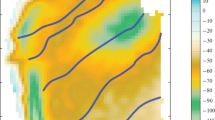Abstract
Application of modern global geopotential models to estimate the navigation informativity of the Earth’s anomalous gravity field (EAGF) is considered from the viewpoint of its use in autonomous (correlation- extreme) navigation. Various algorithms for calculating the characteristics of route and area navigation informativity, for which the authors use the variance and correlation radius of a measured EAGF parameter, are presented. The results of the experimental studies on estimation of the EAGF navigation informativity are discussed by analyzing vertical deflections and second derivatives of the perturbing potential in the Sea of Okhotsk with the use of the model EGM-2008 to degree 2190. It is shown that second derivatives of the geopotential demonstrate higher informativity as applied to navigation purposes.
Similar content being viewed by others
References
Beloglazov, I.N., Dzhandzhgava, G.I., and Chigin, G.P., Osnovy navigatsii po geofizicheskim polyam (Fundamentals of Navigation by Geophysical Fields), Moskva: Nauka, 1985.
Dzhandzhgava, G.I., Gerasimov, G.I., and Avgustov, L.I., Navigation and guidance by spatial geophysical fields, Izvestiya YuFU. Tekhnicheskie nauki, 2013, no. 3 (140), pp. 74–84.
Stepanov, O.A. and Toropov, A.B., Nonlinear filtering for map-aided navigation. Part 1. An overview of algorithms, Gyroscopy and Navigation, 2015, vol. 6, no. 4, pp. 324–337.
Stepanov, O.A. and Toropov, A.B., Nonlinear filtering for map-aided navigation. Part 2. Trends in the algorithm development. Gyroscopy and Navigation, 2015, vol. 6, no. 4, pp. 324–337.
Stepanov, O.A., Primenenie teorii nelineinoi fil’tratsii v zadachakh obrabotki navigatsionnoi informatsii (Application of Nonlinear Filtering Theory for Navigation Data Processing), St. Petersburg: Elektropribor, 1998.
Stepanov, O.A., Sokolov, A.V., and Toropov, A.B., et al., Choosing informative trajectories in correlationextreme navigation taking into account the errors in maps and sensors, Materialy 29 konferentsii pamyati vydayushchegosya konstruktora giroskopicheskikh priborov N.N. Ostryakova (Proceedings of the 29th Conference in Memory of N.N. Ostryakov), St. Petersburg: Elektropribor, 2014, pp. 217–225.
Wang, F., Wen, X., and Sheng, D. Observability analysis and simulation of passive gravity navigation system, Journal of Computers, 2013, vol. 8, no 1, pp. 248–255.
Richeson, J.A., Gravity gradiometer-aided inertial navigation within non-GNSS environments: Dissertations. USA, Washington: University of Maryland, 2008.
Kalinovski, AA, Kovalev, V.A, Dmitruk, A.A., et al., Searching for informative sections on satellite images to refine the coordinates of UAVs, Materialy 8 Vserossiis koi mul’tikonferentsii (The Materials of the 8th All-Russian Multiconference in 3 volumes), Rostov-na-Donu: Izdatel’stvo Yuzhnogo federal’nogo universiteta, 2015, pp. 203–205.
International Centre for Global Earth Models (ICGEM) URL: http://icgem.gfz-potsdam.de.
Pavlis, N. K., Holmes, S.A., Kenyon, S.C., and Factor, J.K., The development and evaluation of the Earth Gravitational Model 2008 (EGM2008), Journal of Geophysical Research, 2012, vol. 117, b04406, doi 10.1029/2011jb008916
Levitskaya, Z.N., Statistical models of anomalous characteristics of the Earth’s gravitational field, in Gravimetricheskie issledovaniya na more (Marine Gravimetric Surveys), Moskva, 1988, pp. 26–47.
Pellinen, L.P. and Neiman, Yu.M., Physical geodesy, in Itogi nauki i tekhniki. Ser. Geodeziya i aerofotos”emka (The results of Science and Technology), Series Geodesy and aerial photography, Moskva: VINITI, 1980, vol.18.
Dem’yanov, V.V. and Savel’eva, E.A., Geostatistika: teoriya i praktika (Geostatistics: Theory and Practice), Moskva: Nauka, 2010.
Serkerov, S.A., Korrelyatsionnye metody analiza v gravirazvedke i magnitorazvedke (Correlation Methods of Analysis in Gravity and Magnetic Surveys), Moskva: Nedra, 1986.
Nepoklonov, V.B., Computer models of the Earth’s anomalous gravity field, Izvestiya vuzov. Ser. Geodeziya i aerofotos”emka, 1998, no. 6, pp. 104–106.
Barthelmes, F. Definition of functional of the geopotential and their calculation from spherical harmonic models, Helmholtz-Zentrum Potsdam–DeutschesGeoForschungsZentrum–Scientific Technical Report STR09/02, 2009.
Neiman, Yu.M., Variatsionnyi metod fizicheskoi geodezii (The Variational Method of Physical Geodesy), Moskva: Nedra, 1979.
Author information
Authors and Affiliations
Corresponding author
Additional information
Original Russian Text © V.N. Koneshov, V.B. Nepoklonov, L.I. Avgustov, 2016, published in Giroskopiya i Navigatsiya, 2016, No. 2, pp. 95–106.
An erratum to this article is available at http://dx.doi.org/10.1134/S2075108716050011.
Rights and permissions
About this article
Cite this article
Koneshov, V.N., Nepoklonov, V.B. & Avgustov, L.I. Estimating the navigation informativity of the Earth’s anomalous gravity field. Gyroscopy Navig. 7, 277–284 (2016). https://doi.org/10.1134/S2075108716030081
Received:
Published:
Issue Date:
DOI: https://doi.org/10.1134/S2075108716030081




